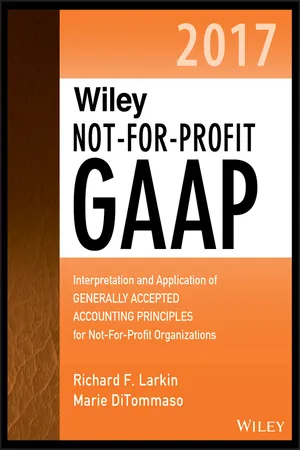
Wiley Not-for-Profit GAAP 2017
Interpretation and Application of Generally Accepted Accounting Principles
Richard F. Larkin, Marie DiTommaso, Warren Ruppel
- English
- ePUB (apto para móviles)
- Disponible en iOS y Android
Wiley Not-for-Profit GAAP 2017
Interpretation and Application of Generally Accepted Accounting Principles
Richard F. Larkin, Marie DiTommaso, Warren Ruppel
Información del libro
The essential not-for-profit GAAP reference, updated with the latest standards
Wiley Not-for-Profit GAAP 2017 is the essential accounting resource for not-for-profit organizations, providing quick access to the most up-to-date standards and practical tools for implementation. Designed help you find the answers you need quickly and easily, this guide features helpful visual aids alongside detailed explanations tailored to the not-for-profit sector. Authoritative discussion covers Financial Accounting Standards Board (FASB) Accounting Standards Codification, which includes the standards originally issued in the Statements, Interpretations and Technical Bulletins; Accounting Principles Board Opinions, Accounting Research Bulletins, AICPA Statements of Position and FASB Emerging Issues Task Force statements relevant to the not-for-profit organization.
The unique characteristics of the not-for-profit organization demand adherence to specific GAAP; auditors and preparers must understand these standards, stay up-to-date as they continue to evolve and know how to apply them in the course of real-world financial statement preparation. This book provides the guidance you need in a user-friendly format.
- Get up to date on the latest changes to GAAP affecting not-for-profit organizations
- Reference authoritative standards for measurement, presentation and disclosure
- Consult flowcharts, diagrams and charts to find answers at a glance
- Double-check disclosures against a checklist of GAAP requirements
Accounting standards are constantly changing, and the special requirements targeting not-for-profits add an additional challenge to full compliance. Instead of wading through dozens of volumes of official pronouncements to locate relevant information, consult an all-in-one resource targeted specifically to not-for-profit GAAP — one that is updated annually to bring you the most current information available. Wiley Not-for-Profit GAAP 2017 provides clear answers and practical guidance to help you streamline GAAP implementation and ensure compliance.
Preguntas frecuentes
Información
Part 1
Overview of Not-for-Profit Organizations
1
Overview of Not-for-Profit Organizations
- Perspective and Issues
- Key Differences between Not-for-Profit and Profit Organizations
- Resource Use Consideration
- Generally Accepted Accounting Principles
Perspective and Issues
- They receive contributions from significant resource providers who do not expect a commensurate or proportionate monetary return.
- They operate for purposes other than to make a profit.
- There is an absence of ownership interests like those of business enterprises.
- Keeping financial records;
- Preparing accurate and meaningful financial statements;
- Budgeting and anticipating financial problems;
- Safeguarding and managing the organization's financial assets;
- Complying with federal and state reporting requirements.